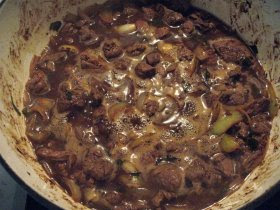Carbonnade is like the chili con carne of Belgium. Everyone seems to have their own recipe, or lack thereof, and the basic concept is wide open for creative variation. It's also pretty easy to cook. Here it is, in a nutshell: Heat a little oil in a stockpot or Dutch oven, then brown your beef chunks in it. Remove the meat and sauté some onions, adding a little beer to help deglaze. Then put the meat back in, adding enough beer just to cover. Bring it to a boil, cover, and simmer on the stovetop or in the oven for 90 minutes to two hours. Taste it, add thyme, salt and pepper as necessary. Or whatever else you think it needs. Simmer uncovered on the stovetop until thickened to your liking. Voila.
Heat a little oil in a stockpot or Dutch oven, then brown your beef chunks in it. Remove the meat and sauté some onions, adding a little beer to help deglaze. Then put the meat back in, adding enough beer just to cover. Bring it to a boil, cover, and simmer on the stovetop or in the oven for 90 minutes to two hours. Taste it, add thyme, salt and pepper as necessary. Or whatever else you think it needs. Simmer uncovered on the stovetop until thickened to your liking. Voila.
That's the minimalist version. Here's the nitty:
What beer to use? The classics are a nice dubbel like Westmalle or a Flemish red/brown like Rodenbach. I've also had great success with Mc Chouffe. The truth: It doesn't matter that much, because as it simmers the beefy flavor will take the lead and put the beer in the backdrop. What does matter is that it's (a) not bitter, and (b) not too expensive. You're cooking with it, after all. I once used Westvleteren to see if it would make a difference, and frankly I should be shot for even thinking it. If you're in the U.S. and want a cheaper, more available option, try New Belgium Abbey. But anything malty and fruity rather than bitter will probably work just fine.
What other ingredients? This is the fun part. Some people add beef broth and/or tomato paste to the liquid; I think it's unnecessary and detracts from the subtle beeriness. I do like to add some minced garlic to the onions. Carrots are fair game. Prunes are fairly common and tasty, drawing out the beer's fruitiness. Sliced mushrooms can be nice too, but add them later if you want to taste them. A whole range of herbs and spices could go in there. I visited my neighbor last night and he was chucking in a Chinese five-spice blend and cayenne pepper – I was skeptical until I tasted it. Finally, five to 10 minutes before serving, you can also finish it with a tablespoon of Dijon mustard and/or fruit jam, like blackberry.
How best to thicken it? You can flour your meat in the first place, but this browns the flour rather than the meat. That takes away from the nice seared-beef flavor. Instead I add flour to the onions and stir it in, before deglazing with the beer. You can also add a paste of flour and water in the later simmering. It's common in Belgium to finish with a hunk of bread and let it soak in, for added thickness and texture. And of course you can always let it cook down. How long should it take? Two to three hours, start to finish, but most of that is unwatched simmering. Remember that – like chili – it tastes even better after a night or two in the fridge.
How long should it take? Two to three hours, start to finish, but most of that is unwatched simmering. Remember that – like chili – it tastes even better after a night or two in the fridge.
What to serve it with? In Belgium it's usually a heaping pile of frites. Nothing wrong with that. At home we prefer a heaping pile of mashed potatoes, all the better to soak up that sauce. More importantly, don't forget to have it with lots of the same beer you used for the stew.
As you enjoy it, assuming you played around with ingredients, take pride in the fact that nobody will ever be able to duplicate it. Not even you.
And if you have your own variations or suggestions, please share them.
Friday, October 17, 2008
How to Make Your Own Personal Carbonnade.
Subscribe to:
Post Comments (Atom)






Nice! Simple recipe. I made something like this a few months ago, but I didn't keep it quite as simple, and of course it didn't turn out quite as good as this sounds. I used Rodenbach, although I think next time I'll use a St. Feuillien Brune or a Chimay Bleu. I'm the king of spontaneous ingredients, so I am going to have some fun with this real soon.
ReplyDeleteWhat do you think about adding the chopped up mix of crudites that you get for mussels and pouring that in instead of just onions?
Sure, why not? The veggies mostly disappear into the sauce after long simmering anyway. The crudités could add nice texture and aroma. I think. Worth a try.
ReplyDelete